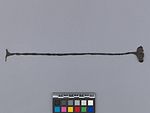kissi penny (Money)
About this object
History of use
Commonly known individually as a kissi (or kisi) penny due to their original association with the Kissi people. Also known as guenze, koli, or kilindi. The 'pennies' were an iron currency made in Sierra Leone that once circulated widely in the vicinity, among various peoples in Liberia, Sierra Leone, and Guinea, from the late 19th century to the first half of the 20th century. The currency was forged using iron smelted from the rich ore in the region, by local blacksmiths. The pieces vary from 9 to 16 inches in length, with longer pieces representing higher values. Larger values were also created by twisting several pieces together or bundling them together in groups of around 20 pieces. European travelers of the time regarded them as a curious form of currency, so many were collected and gifted to museums. Kissi pennies continued to circulate for decades alongside European and American paper currencies, introduced during colonial occupations in West Africa. Colonial governments started to ban their use during the 1940s, however they could still be found in use as currency in rural areas and in ceremonial rituals, as bride wealth, and as protective fetishes for graves. If a penny broke, it could no longer circulate; its value could only be restored by a religious practitioner, who would be paid to conduct a ceremony in which the pieces would be rejoined, which was said to reincarnate the escaped soul. As a result, kissi pennies are often referred to as ‘money with a soul’.
Cultural context
currency; trade
Iconographic meaning
The characteristic form is a twisted rod of iron with flattened ends: a flat, hoe-like spatula at one end and a sharpened ‘T’ at the other. These hammered out ends are referred to as the nileng (ear) and kodo (foot).
Physical description
Long thin piece of twisted iron known as a kissi penny. A twisted shaft separates a roughly shaped rounded flat end, and a short dual-pointed end, running perpendicular to the shaft. Part of the flattened end has been removed.
Categories
Materials
Date Acquired
14 Sep 2010
How Acquired
Donated
Credit Line
Measurements
Overall: 27.5 cm x 3.2 cm x 1 cm
Object Number
2815/20
